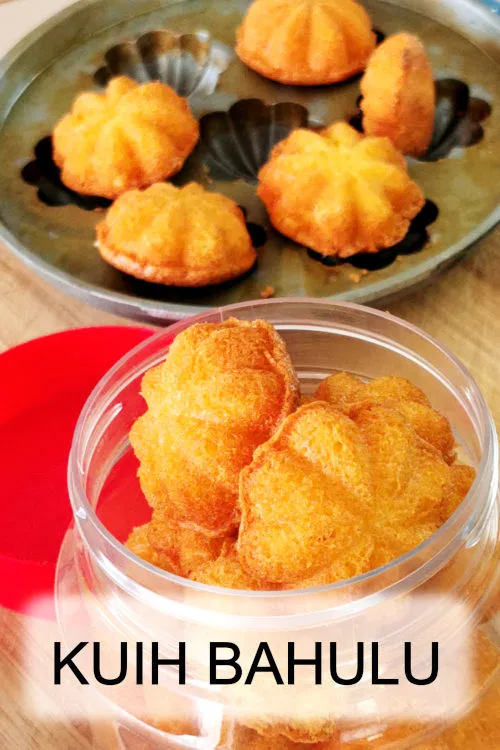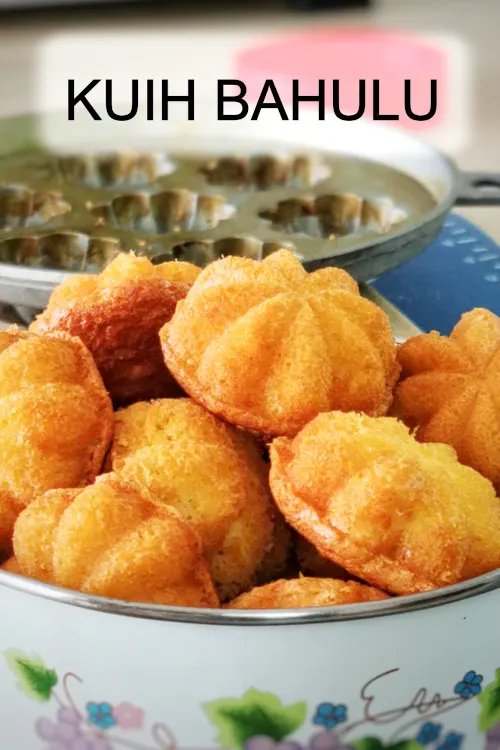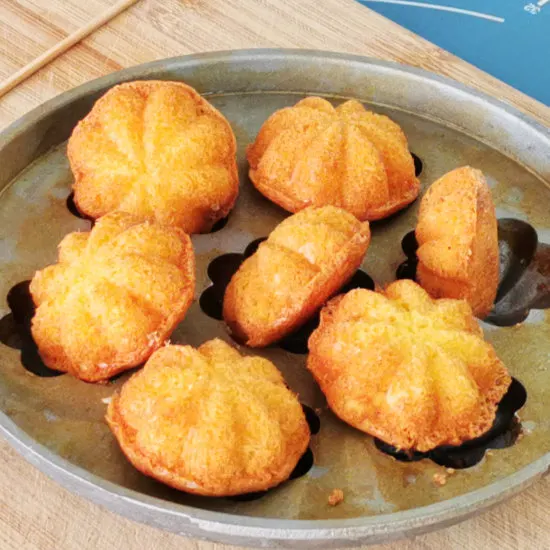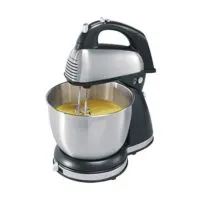Kuih bahulu are hugely popular mini sponge cakes that originated in Malaysia. It is also spelled as kueh bahulu and kuih baulu, called Ji Dan Gao/ 鸡蛋糕 in Chinese, and Kue bolu kering in Indonesia. The name bahulu is likely the corruption of the Malacca Kristang word bolu, which means cake.
This kuih (traditional Malay pastry) is usually served during Eid al-Fitr, Chinese New year, and other festive seasons. It is also a popular snack for daily afternoon tea for the locals.
The making of kuih bahulu is similar to French madeleines. They are small cakes baked in specially made molds. However, it involves only a few basic ingredients and has a crispy exterior with a spongy texture inside.
I only use plain flour, cornstarch, egg, sugar, and salt in this recipe without adding butter and baking powder. I also made it less sweet to be relatively healthier than other madeleines.
Note: This post may contain affiliate links. Please read my privacy policy for more info. I may receive commissions for purchases made through links in this post. As an Amazon Associate, I earn from qualifying purchases.

Here is the step-by-step guide on how to make kuih bahulu.
1. Heat and grease the mold
You need a special bahulu mold to make this cake. The mold is either made with aluminum or brass molds. It comes in different sizes and shapes, and the most common ones are star shape, fish shape, and seashells.
If you do not have the special kuih bahulu molds, you can use a madeleines pan, egg tart molds, or muffin cups.
Here are the steps:
- Brush the mold with a generous amount of vegetable oil or melted butter. This is especially important if you use the mold for the first time.
- Next, heat the mold in the oven at 200°C/390°F for fifteen minutes until the mold is very hot.
2. Beat the eggs
Let’s prepare the egg batter while heating the mold.
Whip the eggs
- Crack the eggs in a large glass or stainless steel mixing bowl. I prefer using eggs at room temperature as You can whip up the eggs quickly compared to cold eggs.
- Whip the egg with an electric mixer at high speed for about 2 minutes, then add the castor sugar bit by bit in the next two minutes until all the sugar is added to the egg mixture.
- The mixture will gradually thicken, changing from bright to pale yellow, with a fluffy texture. When this is achieved, reduce to medium speed and continue beating.
- The endpoint of whipping the eggs is when you can draw a ribbon on the batter, which will only vanish after two seconds. Once the batter has reached the ‘ribbon stage,’ it is time to add the dry ingredients.
Add the flour
- Measure the flour, cornstarch, and salt and mix well, then sieve.
- Fold 1/3 of the flour mixture into the egg mixture. Fold gently until there is no visible flour. Then repeat the remaining two parts until all the flour has been incorporated into the egg batter.
Note:
- Some recipes suggest drying the flour mixture at 220°C/ 430°F in the oven for three minutes to remove the moisture from the flour mixture. This purpose is to produce a soft and light interior of the bahulu. I test it and compare and decide to skip it as the difference is insignificant.
- You can warm the bowl of egg mixture in a hot water bath to increase the temperature, which helps to foam the mixture and shorten the time required.
- There is no need to separate the egg whites from the egg yolks in this recipe. The volume will triple as long as you continue beating with the electric mixer over a hot water bath.
- You may add some vanilla extract or pandan extract to improve the flavor.
- One large egg is about 50g (excluding the weight of the shell). However, I would suggest using a digital weighing matching to measure as the accuracy of the amount of each ingredient is crucial to this recipe.

3. Bake the kuih bahulu
- Remove the heated bahulu mold from the oven and immediately fill the mold with the egg batter. You need to use hot molds, or else the cakes will tend to stick to the mold when you dislodge them. The easiest way to fill the mold is to transfer the batter into a piping bag and pipe it into the tiny molds.
- Place the filled mold on the wire rack, and place it at the midsection of the preheated oven.
- Bake the cake at 200°C/390°F for about twelve minutes, or until the surface of the bahulu turns golden brown.
- Remove the bahulu with a bamboo skewer from the mold.
- Clean the mold if there is any debris of the cake remains and brush with more oil before adding the next batch of batter to bake again.
Note:
- The bahulu is best to eat while the outer part is still crusty and best to enjoy with a cup of coffee.
- If you make a large batch, seal up the tip of the piping bag with a clip, and keep the remaining batter in the chiller before piping it after the first batch of baking. This method helps to prevent the batter from deflating.
4. Storage
- After the kuih bahulu has returned to room temperature, transfer into an airtight container. These mini sponge cakes can last for a week at room temperature.
- If you do not eat the bahulu immediately, reheat the bahulu in the oven or toaster at 120°C/250°F for three minutes. The surface of the bahulu will crisp up again.
5. Other related recipes
If you like this traditional cake recipe, here are some other cake recipes on this food blog that you may want to try:
- Castella is an egg sponge cake that is popular in Japan. The texture is different from bahulu, which is worth trying.
- Butter cake is the most popular cake in the cafe I worked at before. Here is the complete documentation of how to make this cake in the restaurant.

Kuih bahulu - How to make ji dan gao (traditional sponge cake recipe)
Kuih bahulu is a hugely popular mini sponge cake that originated in Malaysia. It is also a popular snack for daily afternoon tea for the locals. The making of kuih bahulu is similar to French madeleines. They are small cakes baked in specially made molds.
Ingredients
- 2 large eggs*
- 50g caster sugar
- 50g all-purpose flour
- 5g cornstarch
- 1/8 tsp salt
Instructions
- Brush the mold with a generous amount of vegetable oil.
- Next, heat the mold in the oven at 200°C/390°F for fifteen minutes.
- Whip the egg with an electric mixer at high speed for about 2 minutes, then add the castor sugar bit by bit until all the sugar is added to the egg mixture.
- The endpoint of whipping the eggs is when you can draw a ribbon on the batter, which will only vanish after two seconds.
- Measure the flour, cornstarch, and salt and mix well, then sieve.
- Fold 1/3 of the flour mixture into the egg mixture. Fold gently until there is no visible flour. Then repeat the remaining two parts until all the flour has been incorporated into the egg batter.
- Transfer the batter into a piping bag.
- Remove the heated bahulu mold from the oven and immediately fill the mold with the egg batter.
- Bake the cake at 200°C/390°F for about twelve minutes, or until the surface of the bahulu turns golden brown.
- Remove the bahulu with a bamboo skewer from the mold.
Notes
The amount of 2 eggs is 90g (exclude the shell) in this recipe. Please adjust accordingly if the eggs you use are of different sizes.
Recommended Products
As an Amazon Associate and member of other affiliate programs, I earn from qualifying purchases.
-
 RICCLE Disposable Piping Bags 12 Inch - 100 Anti Burst Pastry Bags - Icing Piping Bags for Frosting - Ideal for Cakes and Cookies Decoration
RICCLE Disposable Piping Bags 12 Inch - 100 Anti Burst Pastry Bags - Icing Piping Bags for Frosting - Ideal for Cakes and Cookies Decoration -
 Madeleine Mold Cake Pan Non-Stick Scallop Madeleine Bakeware Set Cookie/Macaron/Shell/Dessert Baking Pan (XJZ-12*2-madeleine)
Madeleine Mold Cake Pan Non-Stick Scallop Madeleine Bakeware Set Cookie/Macaron/Shell/Dessert Baking Pan (XJZ-12*2-madeleine) -
 StesoSHOP Wooden Skewers Premium Quality – Set of 60 Beech Wood Skewers 12-inch – Practical Wooden Sticks for Appetizers Fruits Kebab – Durable and Sturdy – Solid Wood – Suitable for Crafts and Food
StesoSHOP Wooden Skewers Premium Quality – Set of 60 Beech Wood Skewers 12-inch – Practical Wooden Sticks for Appetizers Fruits Kebab – Durable and Sturdy – Solid Wood – Suitable for Crafts and Food -
 Hamilton Beach 64650 6-Speed Classic Stand Mixer, Stainless Steel, 4-Quart Bowl and Accessories
Hamilton Beach 64650 6-Speed Classic Stand Mixer, Stainless Steel, 4-Quart Bowl and Accessories
Nutrition Information:
Yield: 21 Serving Size: 1Amount Per Serving: Calories: 26Total Fat: 0gSaturated Fat: 0gTrans Fat: 0gUnsaturated Fat: 0gCholesterol: 18mgSodium: 20mgCarbohydrates: 4gFiber: 0gSugar: 2gProtein: 1g
This data was provided and calculated by Nutritionix on 3/16/2022

KP Kwan
Thursday 17th of March 2022
Hi, this is KP Kwan. I am happy to see you in this comment area, as you have read through my recipe. I am glad to reply to any questions and comments as soon as possible.